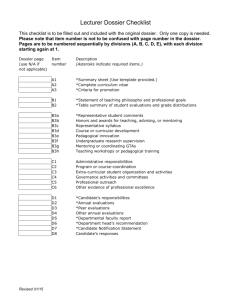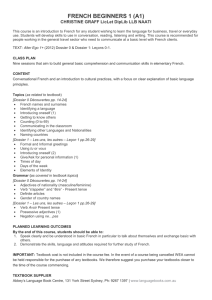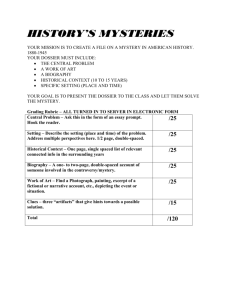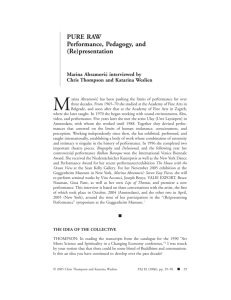InSciT2006 Full Paper Template - Department of Computer Science
advertisement
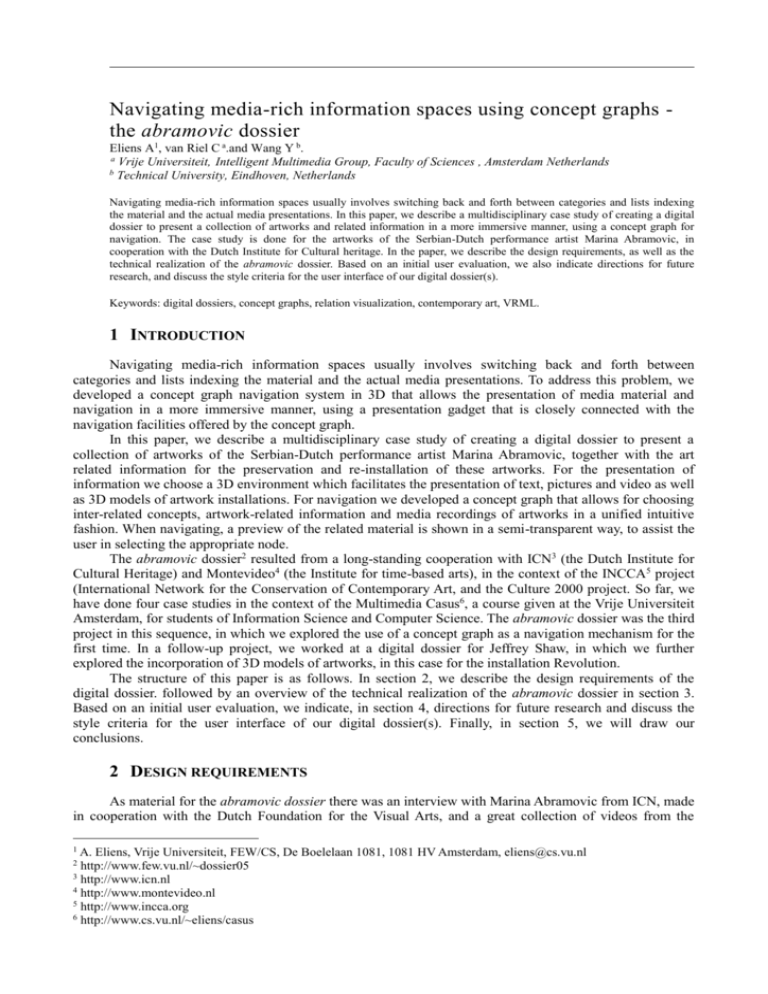
Navigating media-rich information spaces using concept graphs the abramovic dossier Eliens A1, van Riel C a.and Wang Y b. a Vrije Universiteit, Intelligent Multimedia Group, Faculty of Sciences , Amsterdam Netherlands b Technical University, Eindhoven, Netherlands Navigating media-rich information spaces usually involves switching back and forth between categories and lists indexing the material and the actual media presentations. In this paper, we describe a multidisciplinary case study of creating a digital dossier to present a collection of artworks and related information in a more immersive manner, using a concept graph for navigation. The case study is done for the artworks of the Serbian-Dutch performance artist Marina Abramovic, in cooperation with the Dutch Institute for Cultural heritage. In the paper, we describe the design requirements, as well as the technical realization of the abramovic dossier. Based on an initial user evaluation, we also indicate directions for future research, and discuss the style criteria for the user interface of our digital dossier(s). Keywords: digital dossiers, concept graphs, relation visualization, contemporary art, VRML. 1 INTRODUCTION Navigating media-rich information spaces usually involves switching back and forth between categories and lists indexing the material and the actual media presentations. To address this problem, we developed a concept graph navigation system in 3D that allows the presentation of media material and navigation in a more immersive manner, using a presentation gadget that is closely connected with the navigation facilities offered by the concept graph. In this paper, we describe a multidisciplinary case study of creating a digital dossier to present a collection of artworks of the Serbian-Dutch performance artist Marina Abramovic, together with the art related information for the preservation and re-installation of these artworks. For the presentation of information we choose a 3D environment which facilitates the presentation of text, pictures and video as well as 3D models of artwork installations. For navigation we developed a concept graph that allows for choosing inter-related concepts, artwork-related information and media recordings of artworks in a unified intuitive fashion. When navigating, a preview of the related material is shown in a semi-transparent way, to assist the user in selecting the appropriate node. The abramovic dossier2 resulted from a long-standing cooperation with ICN3 (the Dutch Institute for Cultural Heritage) and Montevideo4 (the Institute for time-based arts), in the context of the INCCA5 project (International Network for the Conservation of Contemporary Art, and the Culture 2000 project. So far, we have done four case studies in the context of the Multimedia Casus6, a course given at the Vrije Universiteit Amsterdam, for students of Information Science and Computer Science. The abramovic dossier was the third project in this sequence, in which we explored the use of a concept graph as a navigation mechanism for the first time. In a follow-up project, we worked at a digital dossier for Jeffrey Shaw, in which we further explored the incorporation of 3D models of artworks, in this case for the installation Revolution. The structure of this paper is as follows. In section 2, we describe the design requirements of the digital dossier. followed by an overview of the technical realization of the abramovic dossier in section 3. Based on an initial user evaluation, we indicate, in section 4, directions for future research and discuss the style criteria for the user interface of our digital dossier(s). Finally, in section 5, we will draw our conclusions. 2 DESIGN REQUIREMENTS As material for the abramovic dossier there was an interview with Marina Abramovic from ICN, made in cooperation with the Dutch Foundation for the Visual Arts, and a great collection of videos from the 1 A. Eliens, Vrije Universiteit, FEW/CS, De Boelelaan 1081, 1081 HV Amsterdam, eliens@cs.vu.nl http://www.few.vu.nl/~dossier05 3 http://www.icn.nl 4 http://www.montevideo.nl 5 http://www.incca.org 6 http://www.cs.vu.nl/~eliens/casus 2 Institute for Time-based Arts. In addition, a transcription of the contents of the interview made by Michela Negrini, a student of media art at the University of Amsterdam, who also provided an interpretation as well as a categorization of the works of art. The digital dossier for the artist Marina Abramovic had to satisfy the following requirements: It must serve as an information source for conservators and curators of contemporary art, It must present rich media recordings of all artworks, and, In addition, it must provide background information for the general public (non-expert users). The abramovic dossier was developed in 2004 as a collective student project (including students from Computer Science, Information Science and Artificial Intelligence) at the Vrije Universiteit, Amsterdam. The directive with which the students where set to work was, quoting Ted Nelson: everything must be highly intertwinkled. Since virtual museums are by now a common phenomenon, and the virtual atelier for Marinus Boezem7 that was realized in a previous Casus [1], may be considered to be just a variant of this, the 2004 autumn group decided to explore alternative ways of presentation and navigation, in particular the use of a concept graph. Discussion – on the notion of immersion As indicated in the introduction, the abramovic dossier was meant to complement the information available in other online resources, by providing an alternative interface to the material. In particular we wished to avoid the common menu and lists structure that forces the user to switch back and forth between the media material and the information giving access to that material. For an understanding of the notion of immersiveness we refer to [2]. In any medium, according to [2], there are two forces at work: immediacy -- a tendency towards transparent immersion, and hypermediacy -- the presence of referential context Immediacy occurs when the medium itself is forgotten, so to speak, as is (ideally) the case in realistic painting, dramatic movies, and (perhaps in its most extreme form) in virtual reality. Hypermediacy may be observed when either the medium itself becomes the subject of our attention as in some genres of modern painting, experimental literature and film making, or when there is an explicit reference to other related sources of information or areas of experience, as in conceptual art, many web sites, and also in CNN news, where apart from live reports of ongoing action, running banners with a variety of information keep the viewers up to date of other news facts. Immersiveness, in other words, is accomplished when the application becomes in some sense transparent, without the user becoming aware of its referential nature. Although an impossible task as such, in creating the abramovic dossier we strived for developing an immersive application, that allows the user to experience the media recordings of the artworks within the information space represented by the application, as for example in a virtual museum. However, given the complexity of the concept space associated with the works of an artist like Marina Abramovic, the virtual museum solution did not seem appropriate, and, as will be described in the next section, we decided to use a concept graph as a navigation mechanism, with an associated presentation gadget that is as much as possible embedded in the concept graph, and as it were pops out of the graph when to user wants to focus on the media presentation of the artwork. Additionally, when exploring the possible choices offered by a the part of the concept graph presented, the user will also get a preview of the material associated with the nodes. 3 REALIZATION OF THE DIGITAL DOSSIER The digital dossier was created with VRML (Virtual Reality Modeling Language), which allows for creating virtual worlds and present them on the web. As a user interface for navigating the digital dossier, we created a concept graph that represents relational information structures. The concept graph allows the user to detect relations and search for information. Unlike a 3D cone tree, [3], where the complete hierarchical structure is presented, only a subset of the relational structure is shown - three levels deep. 7 http://www.cs.vu.nl/~eliens/dossiers/boezem/application/ The presentation of the concept graph is dynamic and actually determined by the user's choice. To compensate for the lack of an instant overview, where all information is shown at once, the user can, as already indicated in the previous section, also use keyword search instead of navigation. Information objects shown in the concept graph are represented by 3D icons. These 3D icons visualize a certain type of information, both conceptual information, that represent categories, and content information types, that represent actual (media) content, including text, pictures and video. When the user moves the mouse pointer over the nodes, a preview is given of the material associated with the node, a brief explanation of the node in the case of a conceptual node and an image (bottom left) and and descriptive text (bottom right) in the case of a media content node. The digital dossier contains different presentation facilities for 2D and 3D content. For 2D media content a visualization facility is needed that is able to present video, images or textual information. This facility is implemented as a content gadget with three windows. In each of the three windows the user can view 2D media content. These windows are positioned in such a way that the user can inspect the information simultaneously. In our experience, three images can be presented at the same time without much visual distortion. Below the three windows a list of all content related to the selected information object is displayed. By using drag-and-drop the user can view content on a window of choice. If necessary, the user can focus on a particular window with a zoom option, to avoid distraction from the other windows. Fig 1. main node Fig.2 presentation gadget Since we adopted 3D technology, we could easily accommodate a 3D model for one of the installation art works by Marina Abramovic. We implemented a plain exhibition room, providing a 3D perspective of the installation Terra Degli Dea Madre that allows the user to manipulate the position of the objects by a click-and-drag function. The 3D environment demonstrates the interactive exploration of the installation of an artwork. By manipulating position and/or angle of objects, museum curators can get insight into how the artwork could be exhibited. At this point, we can only speculate how useful such a reconstruction can be as a tool for the conservator responsible for the re-installation, to play around with the presentation parameters, the positioning in space, the overall size, light and ambient effects. For constructing the actual abramovic dossier, we developed a content management tool, that allows the user to browse and edit existing nodes, and to insert new nodes into the graph. On an implementation level, (VRML) node types included nodes for video, pictures, artworks, and information. All nodes shared a common set of attributes, such as their name, description, preview image and display size. The top level of the concept graph was created using an information node as the main node. Drawing the concept graph requires to calculate which nodes surround the node that is chosen as the center node. Each of the surrounding nodes has a number of surrounding nodes themselves. When the user selects a node, the new configuration is calculated, and the new configuration appears with a fade-in, while the old configuration disappears with a fade-out, animating the transition between the old and the new configuration. 4 ISSUES FOR FUTURE RESEARCH AND DEVELOPMENT An initial usability evaluation (with staff members from ICN and Montevideo) indicated that the concept graph supports both intuitive navigation and relationship detection. However improvement of the visual appearance of the digital dossier is definitely possible and desired. In summary, when demonstrating the application to the interested parties, that is ICN and Montevideo, a number of issues came along, that we will here summarize as a list of questions: what icons should be used to identify the elements of the concept graph? what categories and relationships are most appropriate? how should the information be displayed, simultaneously or more focussed? how do we allow the user to choose between multiple information items? how do we avoid visually disturbing elements? Obviously, although the abramovic dossier was very positively received, these issues must be dealt with to make it a success. Having a first prototype, we needed to rethink our application, not only with regard to its style of presentation but, as we will discuss in the next section, also in terms of its underlying data representation. As indicated in the previous section, for constructing the actual abramovic dossier, we developed a content management tool, that allows the user to browse and edit existing nodes, and to insert new nodes into the graph. However, to preserve the information stored in the digital dossier for future use, we must reconsider the data representation i.e. how the information is stored and structured. To use the information presented by the digital dossier, taking into account future developments in 3D technology or other application contexts, it has to be independent of formatting information. This means that the same information instance can be used for other presentations in a relatively easy way. In particular, in case of the digital dossier the presented information has to be VRML independent. In re-thinking the abramovic dossier, we needed to re-establish what were our goals in developing this application and what our primary data sources. The primary goal, after all, is to support conservators in their task of preserving contemporary art, and to assist them with the re-installation of such artworks. For the next generation of digital dossiers, we stated the following requirements: 1. 2. 3. 4. adaptation of representation to Dublin Core XML-based content management, with php forms develop multiple ways to present the information provide stylesheets to accomodate user preferences wrt style Dublin Core8 is the standard used in the INCCA initiative, to record meta-information about existing information sources. For the abramovic dossier, a collection of record-like structures was developed, together with a simple content-management tool, written in PHP. This content-management system must be adapted to be compatible with the Dublin Core-based resource descriptions, augmented with annotations needed for presentation. Further, we decided that, along with the 3D presentation of the dossier, it would be worthwhile to develop a conversion tool that produces standard web-technology based presentations as well. This approach allows us to assess the usability merits of the 3D dossiers in a comparative way. Finally, as indicated before, an important issue that must be resolved concerns the proper presentation parameters. What do we present to the user? And how do we allow the user to interact with the material presented? Discussion – 2D versus 3D As a follow-up on the abramovic dossier, the 2005 Casus group developed a digital dossier for the artist Jeffrey Shaw9. One interesting aspect of the dossier for Shaw is the availability of a tool environment to learn about the construction and de-construction of the Revolution installation and to experiment with the exhibition space parameters of the artwork, such as the lighting conditions, and the color and texture of the walls and the floor. See also [4]. With the Casus 2005 group there was, however, a strong resistance against using 3D for the concept graph navigation mechanism. So we explored a mixed approach, using 2D for the concept graph, and 3D only for the representation of the Revolution installation, in the tool environment mentioned above. Nevertheless, although the dossier for Shaw does realize many of the goals set for the next generation dossier, indicated in section 4, it did fail in providing an immersive application, in the sense explained in section 2. A further analysis of this failure is given in [5]. At this point, we may remark that it did not achieve a natural transition between browsing the concept space and inspecting/experiencing the media recordings of 8 9 http://www.dublincore.org http://www.few.vu.nl/~casus05 the artwork, thus disrupting the natural flow of attention, as we may call it of the user of the dossier. Nevertheless, as we observed in [6] with regard to the visualization of business processes, the effective use of 3D visualizations does require a certain degree of literacy, that is visual literacy, from the side of the user. In future applications, we must pay more attention to providing adequate instructions to that effect. 5 CONCLUSIONS We have argued that a dynamically presented concept graph, as used in the digital dossier, may provide intuitive navigation when dealing with highly inter-related information structures in 3D space. Instead of presenting a complete view of the hierarchy, the concept graph shows only a subset of the information. Presentation of content is separated from navigation but the digital dossier indicates a strong relation between them. So far, the results of the initial evaluation look very promising for using the concept graph as a navigation paradigm. Evaluation indicates that it is relatively easy to use and that it supports exploratory tasks rather well. As such, the digital dossier can be a solution for dealing with presenting highly interrelated information structures in 3D space. However, to get a more accurate view of the usability of the digital dossier, and in particular concept graphs as a navigation paradigm, we wish to explore more real world applications in the domain of cultural heritage, that may reveal new issues for further development. ACKNOWLEDGEMENTS We gratefully acknowledge the contribution of the following people to the development of the digital dossier: Vrije Universiteit Amsterdam: Tim Verweij, Olaf van Zon, Eric de Boer, Pascal Snijders Blok, Universiteit van Amsterdam: Abeer Mahdi, Jina Menke, Michela Negrini Technische Universiteit Delft: Jurgen Koster The Netherlands Institute for Cultural Heritage: Tatja Scholte, Ijsbrand Hummelen Montevideo: Bart Rutten, Gaby Wijers REFERENCES [1] Hoorn J., Eliens A., Huang Z., van Vugt H.C., Konijn E.A., Visser C.T. (2004), Agents with character: Evaluation of empathic agents in digital dossiers, Emphatic Agents, AAMAS 2004 New York 19 July - 23 July, 2004 [2] Bolter J.D and Grusin R. (2000), Remediation -- Understanding New Media, MIT Press [3] Robertson G.G. and MacKinlay J.D. (1991) , Cone trees: animated 3D visualizations of hierarchical information, Proc. of the SIGCHI Conference on Human factors in computing systems: Reaching through technology, 189 194, New Orleans, Louisiana, United States, March 1991 [4] van Riel C., Eliëns A., Wang Y., Exploration and guidance in media-rich information spaces: the implementation and realization of guided tours in digital dossiers, International Conference on Multidisciplinay Information Sciences and Technologies (InSciT2006) October, 25-28th 2006, Mérida, Spain. [5] Wang Y., Eliëns A., van Riel C., Content-oriented presentation and personalized interface of cultural heritage in digital dossiers, accepted for: International Conference on Multidisciplinay Information Sciences and Technologies (InSciT2006) October, 25-28th 2006, Mérida, Spain [6] Schonhage, B., van Ballegooij, A., Eliens, A. (2000), 3D gadgets for business process visualizations, Proc. of the fifth symposium on Virtual reality modeling language (Web3D-VRML), 131 - 138, Monterey, California, United States, February 2000.

